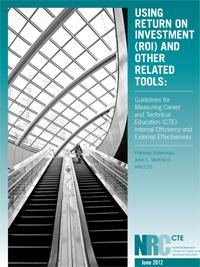Using Return on Investment and Other Related Tools: Guidelines for Measuring Career and Technical Education Internal Efficiency and External Effectiveness
 Using Return on Investment and
Other Related Tools: Guidelines for Measuring Career and
Technical Education Internal Efficiency and External
Effectiveness was developed after the NRCCTE received
numerous requests from the field about how to conduct return on
investment (ROI) studies.
Using Return on Investment and
Other Related Tools: Guidelines for Measuring Career and
Technical Education Internal Efficiency and External
Effectiveness was developed after the NRCCTE received
numerous requests from the field about how to conduct return on
investment (ROI) studies.
The report has two major parts. The first describes different approaches to measuring ROI, describes the steps needed to conduct an ROI study of CTE, and provides a basic protocol that the field might adopt when undertaking ROI studies. The second provides summary abstracts of existing ROI studies—organized by state and the organizational level the study targets (e.g., state, system, or project). A series of appendices provide additional information the field might consider when choosing to follow the common protocol in conducting ROI for CTE.
The field’s need for ROI studies has never been greater, given the pressure on CTE to demonstrate its effectiveness and its efficiency. A major goal of the report was therefore to provide the kinds of information and tools that states and local education agencies need to conduct ROI studies. The report offers a natural starting point for these agencies to generate the hard evidence needed to challenge and refute popular misperceptions regarding the internal efficiency and external effectiveness of CTE held by the broader education and workforce communities.
Kotamraju, P., & Mettille, J. L. III. (2012). Using return on investment (ROI) and other related tools: Guidelines for measuring career and technical education (CTE) internal efficiency and external effectiveness. Louisville, KY: National Research Center for Career and Technical Education, University of Louisville.

